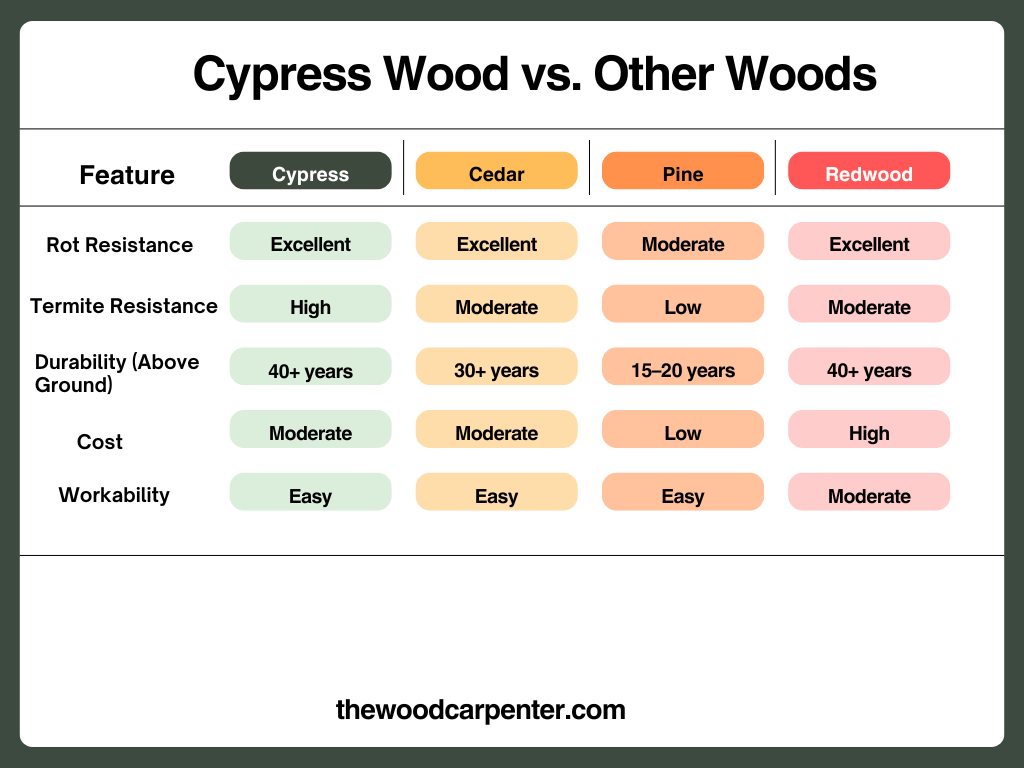
If you’ve ever admired and noticed a house with its rich, honey-colored siding or a dock that’s stood strong through the years of storms, then the chances are there that you’ve already seen a cypress wood in action. This remarkable softwood has been a favorite among builders for centuries — not just for its rustic beauty, but for its incredible natural durability.
Whether you might be designing a outdoor furniture, building a deck, or restoring a classic home, this cypress wood will offer you a rare blend of strength, stability, and timeless charm.
Let’s break down what makes cypress wood such an amazing material, where people use it, and why you may just have to rethink your thoughts on the greatest natural building material that you never knew about.
What Is Cypress Wood?
Cypress isn’t your typical wood. Technically, while it’s a softwood, it acts like a hardwood because of its tight grain and density; naturally resistant to rot and decay. Cypress trees (from the Cupressus or Taxodium family) do well in swampy, coastal environments — particularly in the southern United States, from Maryland to Texas.
What makes cypress so magical is that is, it’s natural oils and resins—oftentimes referred to as cypreine—that repel insects, keep the wood from rotting in the water, and prevent it from growing fungus. This natural defense system means cypress can withstand for years on end — no matter the climate; — even in damp, humid, or coastal environments — with minimal maintenance.
Quick fact: The heartwood from older cypress trees is the most resistant part of the wood. It’s saturated with natural preservative oils making it one of the rot and termite resistance timbers.
Cypress Wood Characteristics
It’s the distinctive physical and mechanical properties of cypress that make it truly special. Here’s a closer look at what makes that so desirable:
1. Natural Resistance
The oils found in its heartwood are so effective at repelling decay that the wood sometimes is called Natures’s Pressure-Treated Lumber, which helps explain its use for various outdoor applications including siding, shingles and decking.
2. Dimensional Stability
Unlike a lot of woods, cypress is resistant to warping, splitting and twisting in the elements. Its stability lends well to indoor and outdoor use, in particular when levels of humidity are changing.
3. Workability
As strong as it is, cypress is just suprisingly easy to cut, shape and mill. It sands to a glossy smooth finish and accepts oils, stains and sealers with supreme ease. Pre-drilling is required when nailing to prevent splitting seasoned lumber.
4. Appearance
Visually, cypress is stunning. The heartwood is light yellow, but can have a minimum of grain patterning with streaks or bands of reddish brown and amber and darker grain lines. Its tight, even grain with the occasional knot gives it a rustic, natural beauty — equally suited to classic and contemporary design.
5. Longevity
When properly installed and cared for, cypress wood can last 40 years or more above ground. Even in direct contact with soil, it can even last 25 years in-ground, according to information from Australian White Cypress (Callitris glaucophylla).
Common Uses of Cypress Wood
Because of its versatility and durability, cypress shows up in more places than you might think. Here are some of its most popular applications:
1. Siding and Cladding
Cypress’s natural weather resistance makes it a top choice for the exterior siding. It can hold up beautifully against the rain, humidity, and pests and also simultaneously maintaining its warm, golden tones. Over the time, untreated cypress develops a silvery-gray patina, a look which many of the homeowners love for its aged, coastal appeal.
2. Decking and Outdoor Structures
From backyard decks to pergolas and gazebos, cypress can handle outdoor exposure with ease. It’s resistant to termites and moisture, making it ideal for coastal regions or humid climates.
3. Roofing Shingles
Because it’s lightweight as well as rot-resistant, cypress shingles are standard in traditional Southern buildings. They last, are easy to install and naturally insulating.
4. Marine Applications
Not many woods work as nicely in and around water as cypress. You’ll see it in piers, boat docks and even small watercraft. Its natural oils keep it from rotting even in wet environments — a primary reason why it has been used on the Gulf Coast for generations.
5. Interior Paneling and Trim
Cypress is not only for the outdoors. With its lovely grain and distinctive warm color, it is a popular interior wall paneling choice for cabinetry, ceilings and trim. It stains evenly and complements ease with rustic, farmhouse or modern organic decors.
6. Furniture Making
Artisans enjoy working with the cypress wood for creating indoor and outdoor furniture due to its light weight, stability, and resistance to rot – perfect qualities for Adirondack chairs, benches, patio tables, etc. It even holds up well in humid conditions without swelling or cracking!
7. Flooring
For those who want a natural, warm-toned floor with a bit of character, cypress flooring delivers. It’s not as hard as oak, but its durability and tight grain make it an excellent option for low-traffic areas.
Cypress Wood vs. Other Woods
There are a few things that distinguish cypress when it comes to comparing with other popular alternatives such as cedar, pine or redwood:

In short: cypress offers redwood-level performance at a more affordable price. It’s the sweet spot between beauty, durability, and cost.
Finishing and Maintenance Tips
Even though cypress has natural protective oils, proper finishing helps it last even longer — especially in outdoor settings.
- For outdoor projects: Use a high-quality oil-based stain or exterior sealer to preserve the wood’s color and prevent graying from UV exposure.
- For indoor use: Apply a clear polyurethane varnish or oil finish to highlight the grain and add a layer of protection.
- Avoid paint buildup: If you prefer a painted finish, make sure the surface is well-primed and properly ventilated.
- Regular upkeep: Re-oil or reseal outdoor cypress every 2–3 years for best results.
Pro tip: Cypress’s natural oils can make gluing a bit tricky. Lightly roughen the surface before applying adhesive for a stronger bond.
Cypress Wood in the U.S. vs. Australia
While Bald Cypress (Taxodium distichum) dominates in the U.S., White Cypress (Callitris glaucophylla) is its Australian counterpart. Both have similar characteristics (great hardness and termite resistance, while displaying a warm golden hue) but White Cypress has a marginally finer grain and more knots to offer it that special decorative appearance.
It’s a go-to for flooring, fencing and construction framing in Australia; while in the U.S., it’s more prevalent in exterior projects and custom woodworking.
Environmental Impact
Cypress is often praised as a sustainable wood option, especially when sourced responsibly. Many cypress lumber suppliers follow selective harvesting practices that allow forests to regenerate naturally. Plus, because of its longevity, cypress structures rarely need replacement — reducing long-term environmental impact.
If environment friendly is important, look for suppliers who are FSC (Forest Stewardship Council) certified or another similar sustainability program.
Pros and Cons of Cypress Wood
✅ Pros
- Naturally resistant to rot, insects, and moisture
- Beautiful natural grain and color
- Long lifespan (up to 40 years or more)
- Easy to work with and finish
- Stable and less prone to warping
- Perfect for both indoor and outdoor use
⚠️ Cons
- Limited availability (especially old-growth cypress)
- Price can be higher than common softwoods like pine
- Natural oils make gluing tricky
- Can weather to gray if left untreated outdoors
Why Choose Cypress for Your Next Project?
If you’re after a wood that balances beauty, toughness, and versatility, cypress deserves a spot at the top of your list. It’s ideal for builders who need durability, DIYers who love a natural finish, and homeowners who want timeless, low-maintenance charm.
From backyard decks to custom cabinetry, after all, cypress wood doesn’t just perform; it ages beautifully too, growing a patina that tells a tale with every year.
FAQs About Cypress Wood
1. Is cypress wood waterproof?
Not completely waterproof, but its natural oils make it one of the most water-resistant woods available. It can withstand outdoor exposure far better than untreated pine or fir.
2. Can you paint or stain cypress wood?
Yes! Cypress takes stains, oils, and paints very well. Just make sure to clean and sand it before finishing for the best result.
3. How long does cypress wood last outdoors?
If they are sealed well, cypress can last 40 years or more above ground — much longer in moderate climates.
4. Is cypress wood expensive?
Cypress costs more than pine but less than redwood or teak. It’s a great mid-range option for those who want natural durability without the luxury price tag.
5. Does cypress wood need to be treated?
Not necessarily. Its heartwood is naturally resistant to decay, but applying a protective finish will extend its lifespan and preserve its color.
Final Thoughts
Cypress wood is one of nature’s most remarkable materials — beautiful, resilient, and built to last. Building a waterfront dock, a warm outdoor lounge or attractive wall panels? No other wood will do, with the natural warmth and durability that cypress offers. Selected carefully and well maintained, cypress isn’t simply a material — it’s an investment in good work that will stand up through time.

